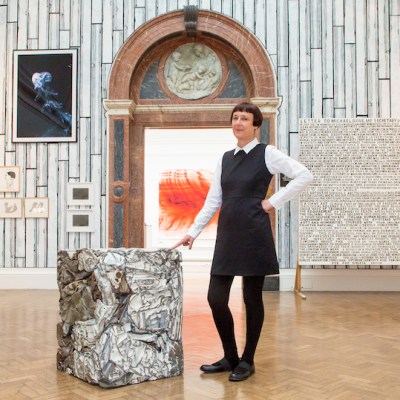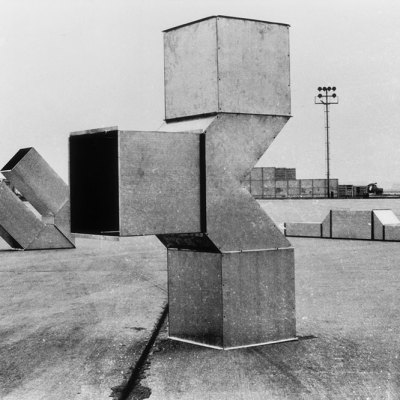In one of the crisp, white galleries of Cornelia Parker’s retrospective at the Tate Britain, there is a small, blue doll. He is a figurine of Oliver Twist, cut in half by, as the wall text tells us, the same guillotine that decapitated Marie Antoinette in 1793. What is the viewer supposed to make of this gesture?
The wall text (penned by the artist herself) suggests a little mischief-making with history: a fictional character suffering the same fate as a historical person. However, Parker is strangely silent on the material or class politics at play here. Shorn of any of its historical context (who owned it? where did it come from?), the doll can do little more than be an effigy of the working class that Twist represented, or perhaps a comment on Dickensian stereotypes of the (white) ‘working poor’: a confusing twist to Parker’s violent joke.
The exhibition is littered with these kind of stumbling blocks. Perhaps I am taking Parker too literally, but her practice – particularly as it sits within the Tate’s hushed halls – is visually so weighty (heavy metals and concepts abound) that I feel unable to enter into the levity that her poetic act might offer. This might be the point, a violent and absurd world meets violent and absurd gestures, but what does it mean that it is Parker who is producing the violence in this space?
Thirty Pieces of Silver (1988–89), Cornelia Parker. Installation view Tate Britain 2022. Photo: Oli Cowling; courtesy Tate.

The objects in the show don’t come to Parker blank, but with their own histories. The exhibition starts with Parker’s infamous Thirty Pieces of Silver. Seductive pools of silver objects, arranged in six rows of five, fill the centre of the first gallery. The only history we are given to all of this silver is how Parker came to acquire it: from car-boot sales, markets, auctions, donations from friends. But each of these objects have older material histories. Silver was extracted with great force from South America by Spanish colonists from the 1500s – an economic imperialism with which France and Britain were quick to compete.
In her notes for the British Art Show in 1990, Parker brought out Thirty Pieces of Silver’s transformative potential: she described the objects as levitating like ghosts, awaiting judgement or resurrection. This sentiment might be compared with Walter Benjamin’s philosophy of history: the spark or instantaneous flash that destabilises as it illuminates an image of the past. Yet Parker does not follow Benjamin’s advice to fan that flame and build out an anti-conformist analysis. Her descriptions of her actions do nothing to acknowledge the initial violence that brought the silver here. Perhaps it is honest for a white British artist to own up to their desire to ‘give into [their] destructive urges’, as Parker says in the wall text, but might we also expect more from art than to (consciously or unconsciously) reproduce society?
It is unclear as to how much Parker has joined these dots. While her voice is so present in this exhibition, her subjectivity is never owned. There is an obvious reason for this – female artists have historically been reduced to and by their gender – but the alternative is not simply to reproduce the neutral white cis male position. Parker frequently collaborates with institutions of state power (the army, customs and excise, prisons, police), and there is, therefore, value in scrutinising the position she is coming from, such as it shapes these interactions.
Magna Carta (An Embroidery), (2015), Cornelia Parker. Courtesy the artist and Frith Street Gallery, London

Magna Carta (An Embroidery) is a 14-metre-long collaborative embroidery of the titular document’s Wikipedia entry. The contributors include several peers of the realm; Maria Balshaw, director of the Tate; and many residing at Her Majesty’s Pleasure. Parker presents this work as replicating Wikipedia’s ‘crowdsourced’ ethos, without a central ‘authority figure’. There is an odd tension between this and the Magna Carta itself – which was, it could be argued, actually the result of personal grievances between an elite class of barons and the Crown. Parker seems swept up in the heady myth of democracy, submerging more troubled history and present with this invented system of collective production that ignores the power structures in which it circulates.
Particularly striking in this vein is a set of ‘Medals of Dishonour’ produced for the Imperial War Museum. They depict the backs of Tony Blair and George W. Bush’s heads, anonymous figures who ‘stand in for any faceless politician […] corrupted by power’. In pandering to a politics of bad apples, Parker displays a fundamental faith in violent structures which feels rather quaint. The final work on display, Island, is a chalk-painted greenhouse and meditation on Brexit. Produced in 2022, this piece feels out of step with current urgencies in British political and social life – the culmination of a show which approaches history with a disquieting aloofness, a quality so tied to our national myths.
‘Cornelia Parker’ is at Tate Britain, London, until 16 October.



